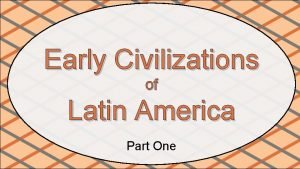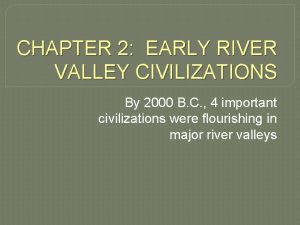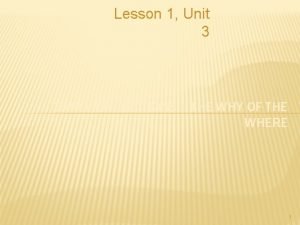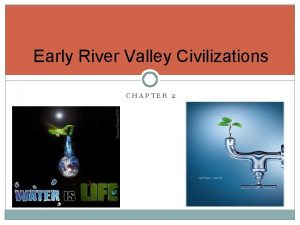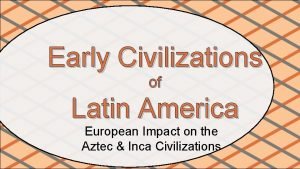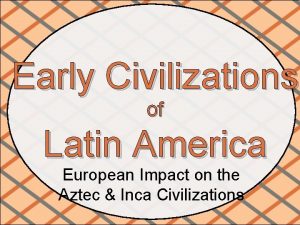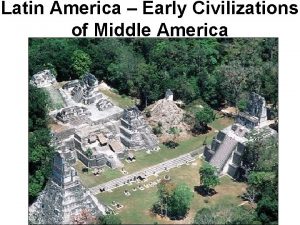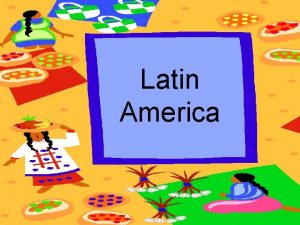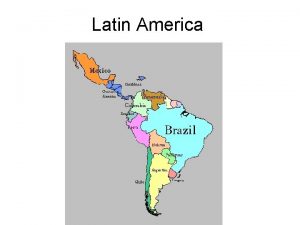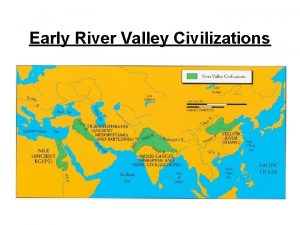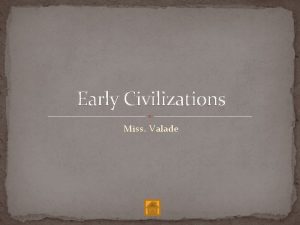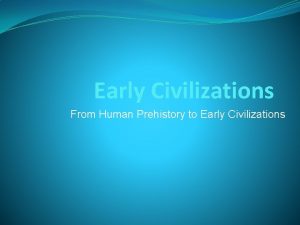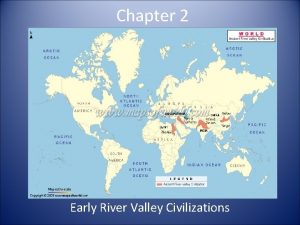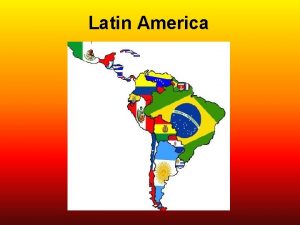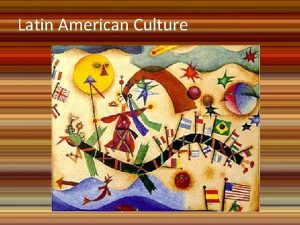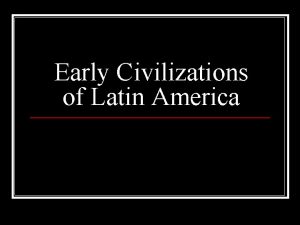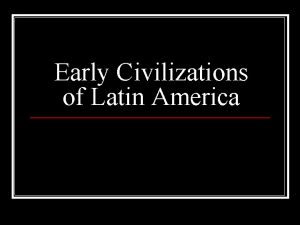Early Civilizations of Latin America European Impact on




























- Slides: 28

Early Civilizations of Latin America European Impact on the Aztec & Inca Civilizations


The Aztecs

Aztec Civilization • Aztecs arrived in the Valley of Mexico in 1100 s (central Mexico, including present day Mexico City). • They wandered about looking for a home site until 1325. • Aztecs finally settled on an island in the middle of Lake Texcoco. • They built a magnificent city called Tenochtitlan (now Mexico City).

Aztec Temple

Diorama of Tenochtitlan

Tenochtitlan • This was the Aztec’s capital. • It was created in the center of a lake! • They built floating islands called “chinampas” by piling rich earth from the bottom of the lake onto rafts made of wood. • Roots of plants grew down to bottom, anchoring the rafts.

Tenochtitlan


Chinampas

Expanding Empire • In the 1400 s, Aztec warriors began conquering other people. • They made them pay taxes; noble Aztecs grew rich. • Aztecs had an emperor; the nobles and priests helped the emperor—all were very wealthy. • Not everyone was rich—most people were farmers.

Eagle Warrio Sculpture

Men’s Work • The Aztec were very involved in agriculture. • They used chinampas (man-made floating islands) to grow crops of vegetables, flowers, grasses, and medicinal plants. • They also hunted and fished.

Women’s Work • The Aztec women spent the day taking care of the children, cooking, knitting, and doing housework.

Women’s Work

Achievements • Doctors developed 1, 000 s of medicines from plants. • Astronomers predicted movements of the planets; designed an accurate calendar! • Priests kept extensive records using hieroglyphics. • Schooling - Boys studied either religion

Aztec Sun Stone (Calendar)

Aztec Golden “Ear Flares”

Mosaic Mask Inlaid with Turquoise

Discipline • How did the Aztecs discipline children? • Some punishments included making them inhale smoke, holding them over fire in which spicy peppers where thrown, and puncturing their skin with thorns!

Aztec Discipline

Religion • Cities were religious centers; they worshipped their gods in pyramid-shaped temples. • Sacrifice was an important part of the religious ceremonies (meant to honor the gods). • Polytheistic (worshipped many gods): Sun, Death, Maize,

Aztec Temple

Temples • Instead of tearing down old temples, Aztec would just keep adding levels to the existing one. • This one was built over 6 times!

Aztec Temple

Religious Ceremonies • The bath was an important part of daily life--not only to be cleaned, but also to be religiously purified. • Most homes had a steam room attached to living quarters. • Other religious ceremonies included human sacrifices: • usually children or prisoners of war • felt that human hearts and blood strengthened the gods

Aztec Bath

Aztec human sacrifice was on a greater scale than anywhere or any time in human history.
 Why called latin america
Why called latin america Early south american civilizations
Early south american civilizations Chapter 9 lesson 1 early civilizations
Chapter 9 lesson 1 early civilizations Chapter 11 section 1 early civilizations of africa
Chapter 11 section 1 early civilizations of africa Chapter 14 pre columbian america answers
Chapter 14 pre columbian america answers River valley civilizations def
River valley civilizations def Geographic luck definition
Geographic luck definition Lesson 1 early civilizations
Lesson 1 early civilizations Chapter 2 early river valley civilizations
Chapter 2 early river valley civilizations Social impact statement for early design review
Social impact statement for early design review Early childhood research quarterly submission guidelines
Early childhood research quarterly submission guidelines Social impact statement for early design review
Social impact statement for early design review Early european exploration and colonization resulted in -
Early european exploration and colonization resulted in - European colonies in north america
European colonies in north america European colonies in north america
European colonies in north america European land claims in north america map
European land claims in north america map European nations settle north america
European nations settle north america European nations settle north america chapter 4 section 2
European nations settle north america chapter 4 section 2 Chapter 20 section 4 world history
Chapter 20 section 4 world history Chapter 20 section 2 european nations settle north america
Chapter 20 section 2 european nations settle north america European nations settle north america
European nations settle north america Early cpr and early defibrillation can: *
Early cpr and early defibrillation can: * Chapter 4 oklahoma in early america
Chapter 4 oklahoma in early america Rap of the states
Rap of the states America asia africa
America asia africa Repetition in let america be america again
Repetition in let america be america again Happening e performance
Happening e performance Peninsularies
Peninsularies Economic imperialism in latin america
Economic imperialism in latin america

